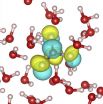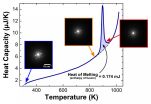(Press-News.org) Worcester, Mass. – People paralyzed by spinal cord injuries lose mechanical strength in their leg bones faster, and more significantly, than previously believed, putting them at greater risk for fractures from minor stresses, according to a new study by a research team at Worcester Polytechnic Institute (WPI).
The results suggest that physicians need to begin therapies for spinal cord injury patients sooner to maintain bone mass and strength. The data also serve as warning to physicians treating patients with osteoporosis to think beyond the standard bone density test when assessing risks of hip and other fractures. Details of the study are reported in the paper "Reduction in Proximal Femoral Strength in Patients With Acute Spinal Cord Injury" published by the Journal of Bone and Mineral Research.
"It's not just a question of how much bone mass is lost, but where that loss is occurring," said Karen Troy, PhD, assistant professor of biomedical engineering at WPI and senior author of the paper. "We found that bone-loss occurred sooner in mechanically important areas and significantly increased the risk of fracture."
Estimates of the number of Americans living with spinal cord injuries range from 300,000 according to the National Spinal Cord Injury Statistical Center to 1.2 million in a study funded by the Christopher and Dana Reeve Foundation. Both sources agree that the leading causes of these injuries are auto accidents, workplace accidents, falls, sports injuries, and violent crime.
Healthy bones adapt to the mechanical forces they encounter, with new bone formation and existing bone resorption constantly occurring to meet the body's needs. When bones stop carrying loads, however, they begin to lose mass and weaken. For patients with spinal cord injuries, this dramatic decline in bone strength often causes broken legs or knees from otherwise minor impact or stresses. "Their bones are so fragile, that just the act of rolling over in bed can snap their knee or leg," Troy said.
In the current study, Troy and her co-authors, W. Brent Edwards at the University of Calgary and Thomas Schnitzer at Northwestern University, captured and analyzed data from 13 spinal cord injury patients treated at the Rehabilitation Institute of Chicago. Each patient received two standard scans (a DXA bone mineral density scan and a CT scan) of their leg bones at specified time intervals for nearly four months after the original injury. The scans documented the change in bone mass over time. The team then used sophisticated computer modeling systems to process the scan data and simulate how the amount and distribution of bone loss would affect the ability to sustain mechanical loads and movements.
That analysis showed that patients in the study lost 2 percent of their leg bone mass each month, yet that correlated with a 6.9 percent loss in leg bone strength. "In just 3.5 months, reductions in strength for some patients were on the order of that predicted for lifetime declines owing to aging," the authors wrote.
Starting therapies early to maintain bone mass and strength is important for these patients, Troy noted, not only to prevent injuries but also to keep patients eligible for treatments and technologies now in development. "In ten or fifteen years, with advances in tissue regeneration to repair the spinal cord, and exoskeleton assist devices, many of these people will have the opportunity to get back on their feet, if their bones are strong enough to carry the load," Troy said. "It's very difficult to restore bone mass once it's lost, so the better approach is to prevent the loss in the first place."
Bone loss and the risk of fracture is also a serious concern for the 54 million people in the United States who have low bone density or osteoporosis. The three-fold difference observed in bone mechanical strength versus density in the current study should prompt additional review of how physicians assess risk and treat patients with this condition. "Bone mineral density is important, but it doesn't tell the whole story," Troy said.
INFORMATION:
About Worcester Polytechnic Institute
Founded in 1865 in Worcester, Mass., WPI is one of the nation's first engineering and technology universities. Its 14 academic departments offer more than 50 undergraduate and graduate degree programs in science, engineering, technology, business, the social sciences, and the humanities and arts, leading to bachelor's, master's and doctoral degrees. WPI's talented faculty work with students on interdisciplinary research that seeks solutions to important and socially relevant problems in fields as diverse as the life sciences and bioengineering, energy, information security, materials processing, and robotics. Students also have the opportunity to make a difference to communities and organizations around the world through the university's innovative Global Perspective Program. There are more than 40 WPI project centers in the Americas, Africa, Asia-Pacific, and Europe.
Combining a PET scanner with a new chemical tracer that selectively tags specific types of bacteria, Johns Hopkins researchers working with mice report they have devised a way to detect and monitor in real time infections with dangerous Gram-negative bacteria. These increasingly drug-resistant bacteria are responsible for a range of diseases, including fatal pneumonias and various bloodstream or solid-organ infections acquired in and outside the hospital.
"What we have produced is essentially a system that localizes the epicenter of infection and provides real-time tracking ...
The National Institute of Standards and Technology (NIST) has published the final version of the US Government Cloud Computing Technology Roadmap, Volumes I and II. The roadmap focuses on strategic and tactical objectives to support the federal government's accelerated adoption of cloud computing. This final document reflects the input from more than 200 comments on the initial draft received from around the world.
The roadmap leverages the strengths and resources of government, industry, academia and standards development organizations to support technology innovation ...
A University of Colorado Cancer Center study recently published in the journal Prostate offers compelling evidence that inflammation may be the link between Vitamin D and prostate cancer. Specifically, the study shows that the gene GDF-15, known to be upregulated by Vitamin D, is notably absent in samples of human prostate cancer driven by inflammation.
"When you take Vitamin D and put it on prostate cancer cells, it inhibits their growth. But it hasn't been proven as an anti-cancer agent. We wanted to understand what genes Vitamin D is turning on or off in prostate cancer ...
Though it garners few public headlines, carbonic acid, the hydrated form of carbon dioxide, is critical to both the health of the atmosphere and the human body. However, because it exists for only a fraction of a second before changing into a mix of hydrogen and bicarbonate ions, carbonic acid has remained an enigma. A new study by Berkeley Lab researchers, has yielded valuable new information about carbonic acid with important implications for both geological and biological concerns.
Richard Saykally, a chemist with Berkeley Lab's Chemical Sciences Division and a professor ...
When studying extremely fast reactions in ultrathin materials, two measurements are better than one. A new research tool invented by researchers at Lawrence Livermore National Laboratory (LLNL), Johns Hopkins University and the National Institute of Standards and Technology (NIST) captures information about both temperature and crystal structure during extremely fast reactions in thin-film materials.*
The combined device will help scientists study new materials and processes used to make advanced technologies, including state-of-the-art semiconductors and flat-screen ...
Abandoned penguin chicks that were hand-reared and returned to the wild showed a similar survival rate to their naturally-reared counterparts, according to a study published October 22, 2014 in the open-access journal PLOS ONE by Richard Sherley from University of Cape Town and colleagues.
The Endangered African penguin population has been rapidly decreasing since 2001. In the Western Cape of South Africa, penguins breed from February to September and moult between September and January, once chicks have fledged. If adult penguins begin the moulting process, a 21 day ...
Wild chimpanzees living in disturbed habitat may use innovative strategies, like foraging crops at night, to coexist with nearby human activities, according to a study published October 22, 2014 in the open-access journal PLOS ONE by Sabrina Krief from Muséum national d'histoire naturelle and colleagues.
People expanding land use for agriculture and other activities are increasingly encroaching on wild chimpanzee habitat. To understand how chimpanzees are adjusting, researchers used camera-traps to observe chimpanzee behavior during incursions out of the forest into ...
VIDEO:
This video shows treatment with OTS964 induced cytokinetic defect with inter-cellular bridges that eventually led to cell apoptosis. Cell pictures were taken every 10 min.
Click here for more information.
A new drug, known as OTS964, can eradicate aggressive human lung cancers transplanted into mice, according to a report in Science Translational Medicine. The drug, given as a pill or by injection, inhibits the action of a protein that is overproduced by several tumor types, ...
Males of great bustard consume small doses of poison with a dual purpose: to eliminate intern parasites and, especially, to look healthier and stronger before females, allowing them to achieve a greater reproductive success. A team of researchers from the Spanish National Research Council has now suggested for the first time that this function of self-medication could be a mechanism of sexual selection. The study results are published in the PLOS ONE journal.
Juan Carlos Alonso, who led the project, CSIC researcher at the Department of Evolutive Ecology of the Spanish ...
A new study conducted by University of North Carolina School of Medicine researchers provides the first known evidence of how a similar acoustic characteristic in the cry sounds of human infants and rat pups may be used to detect the harmful effects of prenatal cocaine exposure on nervous system development.
"These findings are important because studies of prenatal drug exposure in humans are always limited by not knowing if infant nervous system damage was due to the effects of a specific drug, such as cocaine, or the effects of other associated factors, such as maternal ...





